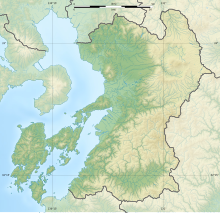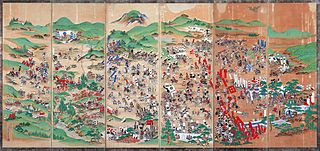
The Battle of Sekigahara, was an important battle in Japan which occurred on October 21, 1600 in what is now Gifu Prefecture, Japan, at the end of the Sengoku period.
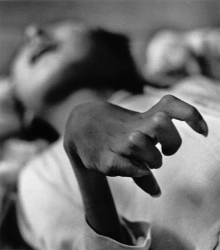
Minamata disease is a neurological disease caused by severe mercury poisoning. Signs and symptoms include ataxia, numbness in the hands and feet, general muscle weakness, loss of peripheral vision, and damage to hearing and speech. In extreme cases, insanity, paralysis, coma, and death follow within weeks of the onset of symptoms. A congenital form of the disease affects fetuses in the womb, causing microcephaly, extensive cerebral damage, and symptoms similar to those seen in cerebral palsy.

Minamata is a city located in Kumamoto Prefecture, Japan. It is on the west coast of Kyūshū and faces Amakusa islands. Minamata was established as a village in 1889, re-designated as a town in 1912 and grew into a city in 1949. As of March 2017, the city has an estimated population of 25,310 and a population density of 160 persons per km2. The total area is 162.88 km2.

The First Barons' War (1215–1217) was a civil war in the Kingdom of England in which a group of rebellious major landowners led by Robert Fitzwalter waged war against King John of England. The conflict resulted from King John's disastrous wars against King Philip II of France, which led to the collapse of the Angevin Empire, and John's subsequent refusal to accept and abide by Magna Carta, which John had sealed on 15 June 1215.

Shimazu Yoshihisa was a powerful daimyō and the 16th Chief of Shimazu clan of Satsuma Province, the eldest son of Shimazu Takahisa. He was renowned as a great general, who managed to subjugate Kyushu through the deft maneuvering of his three brothers. Eventually, in 1585, Yoshihisa seceded control of the entire Kyushu region.
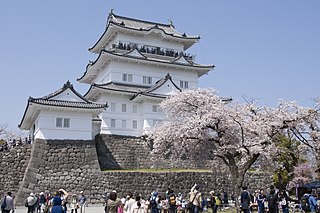
The third Siege of Odawara occurred in 1590, and was the primary action in Toyotomi Hideyoshi's campaign to eliminate the Hōjō clan as a threat to his power. The months leading up to it saw hasty but major improvements in the defense of the castle, as Hideyoshi's intentions became clear. Thus, despite the overwhelming force brought to bear by Hideyoshi, the siege saw little actual fighting.
The Sekigahara Campaign was a series of battles in Japan fought between the Eastern Army aligned with Tokugawa Ieyasu and the Western Army loyal to Ishida Mitsunari, culminating in the decisive Battle of Sekigahara. The conflict was sparked by a punitive expedition led by Ieyasu against the Uesugi clan in the northeastern Tōhoku region, providing Mitsunari with an opportunity to denounce Ieyasu in the name of the infant ruling taikō Toyotomi Hideyori while the Tokugawa troops were in the field.

The third siege of Girona occurred in northern Catalonia, Spain from 6 May to 12 December 1809, during the Napoleonic Wars. A significant event of the Peninsular War, France's Grande Armée lay siege to the town of Girona for seven months. Girona was strategically important because it controlled the main road between France and Spain.
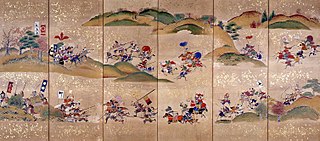
The Siege of Hasedō (長谷堂城の戦い) was one of a series of battles fought in the far north of Japan's main island of Honshū contemporaneous with the famous and decisive campaigns between Tokugawa Ieyasu and Ishida Mitsunari further south.
Events from the year 1646 in England. This is the fifth and last year of the First English Civil War, fought between Roundheads (Parliamentarians) and Cavaliers.
Sagara Yoshihi (相良義陽) (1544–1581) was a Japanese daimyō of the Sengoku period, who ruled a region in southern Higo Province.
Shimazu Toshihisa was a Japanese samurai of the Azuchi-Momoyama period, He called 'Saemon no kami'. he was a third son of Shimazu Takahisa, who served as a general officer and senior retainer of the Shimazu clan of Satsuma Province.

Niiro Tadamoto was a retainer of Satsuma daimyō Shimazu Yoshihisa. He is also known as Jiroshirō. He served under Shimazu Takahisa and then under Yoshihisa. Tadamoto was a skilled samurai called Oni Musashi.
Shimazu Iehisa was a Japanese samurai of the Sengoku period, who was a member of the Shimazu clan of Satsuma Province. He was the fourth son of Shimazu Takahisa. He served in a command capacity during his family's campaign to conquer Kyūshū.

Shin-Minamata Station is a junction passenger railway station located in the city of Minamata, Kumamoto, Japan. It is operated by Kyushu Railway Company and by the third-sector railway company Hisatsu Orange Railway.

The Battle of Saguntum saw the Imperial French Army of Aragon under Marshal Louis Gabriel Suchet fighting a Spanish army led by Captain General Joaquín Blake. The Spanish attempt to raise the siege of the Sagunto Castle failed when the French, Italians, and Poles drove their troops off the battlefield in rout. The action took place during the Peninsular War, part of the Napoleonic Wars. Sagunto lies a short distance from the east coast of Spain, about 30 kilometres (19 mi) north of Valencia.
The siege of Pécs was fought from 14 to 22 October 1686, in the city of Pécs in southwestern Hungary, between the armies of the Ottoman Empire and of the Holy Roman Empire.
The siege of Iwaya Castle (岩屋城の戦い) was fought in the year 1585 when an army of the Shimazu clan put the castle of Iwaya, which belonged to the Takahashi clan who were vassals of the Ōtomo clan, under siege.

The siege of Newcastle occurred during the First English Civil War, when a Covenanter army under the command of Lord General Alexander Leslie, 1st Earl of Leven besieged the Royalist garrison under Sir John Marlay, the city's governor. Eventually, the Covenanters took the city of Newcastle upon Tyne by storm, and the Royalist garrison who still held castle keep surrendered on terms.

Minamata is a 2020 biographical drama film directed by Andrew Levitas, based on the book of the same name by Aileen Mioko Smith and W. Eugene Smith. The film stars Johnny Depp as W. Eugene Smith, an American photographer who documented the effects of mercury poisoning on the citizens of Minamata, Kumamoto, Japan. The film premiered at the Berlin International Film Festival on February 21, 2020. It was released in the United States on February 11, 2022, by Samuel Goldwyn Films. At the 94th Academy Awards in 2022, the film ranked third place in the Oscars Fan Favorite contest.
